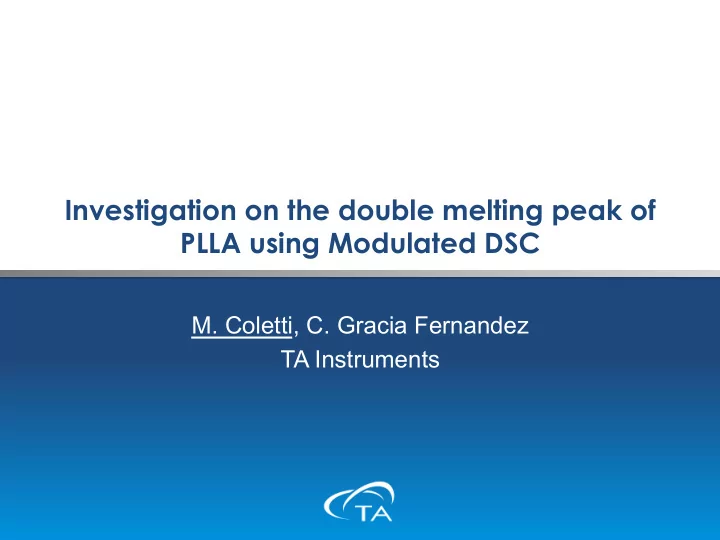

Investigation on the double melting peak of PLLA using Modulated DSC M. Coletti, C. Gracia Fernandez TA Instruments TAINSTRUMENTS.COM TAINSTRUMENTS.COM
TA Instruments • Worldwide manufacturer of equipment for Thermal Analysis, Rheology, Microcalorimetry and ThermoPhysical analysis • Strongly oriented to innovation, has a brand new line of Differential Scanning Calorimeters: the Discovery DSC TAINSTRUMENTS.COM TAINSTRUMENTS.COM
Modulated DSC • Typical DSC tests employ constant gradients of temperature and/or isothermal steps • MDSC superposes an oscillating signal 80 70 Modulated Temp (°C) 60 50 40 18 20 22 24 26 28 Time (min) Universal V4.7B TA Instruments TAINSTRUMENTS.COM TAINSTRUMENTS.COM
Modulated DSC • Sample is exposed to several heating rates and it is possible to separate phenomena that are HR dependent (melting, glass transition) from kinetic phenomena (crystallisation) 0.2 0.2 0.1 0.1 0.1 Nonrev Heat Flow (W/g) Rev Heat Flow (W/g) Heat Flow (W/g) 0.0 0.0 0.0 -0.1 -0.1 -0.1 -0.2 -0.2 -0.2 -0.3 -0.3 50 100 150 200 250 300 Exo Up Temperature (°C) Universal V4.7B TA Instruments TAINSTRUMENTS.COM TAINSTRUMENTS.COM
Problem: PLLA double melting peak • Poly (L-lactic acid) is a widely studied thermoplastic biopolymer • Has a complicated melting process • Here we try to understand better what happens during the melting (after cooling at 40°C/min from the melt) (data from C. Gracia-Fernandez, S. Gomez-Barreiro, J. Lopez-Beceiro, Mater. Res. Vol. 27, No. 10, 2012) TAINSTRUMENTS.COM TAINSTRUMENTS.COM
Heat only MDSC • When studying melting processes with MDSC it is important to follow some guidelines: § At least four oscillations over the peak § Period should be longer than any characteristic time of the process investigated § Use Heat Only: amplitude is set so that the minimum heating rate during modulation at any time is 0°C/min TAINSTRUMENTS.COM TAINSTRUMENTS.COM
Period too short (60s – 2°C/min) TAINSTRUMENTS.COM TAINSTRUMENTS.COM
Testing conditions • Period is prolonged to 120s (to cope with typical crystallisation times) • Heating rate is reduced to 1°C/min (to keep 4 oscillations) • Amplitude is set to 0.32°C (to maintain heat only conditions) TAINSTRUMENTS.COM TAINSTRUMENTS.COM
Proper Rev – NonRev separation • Melting is all in the Rev signal and crystallisation is in the NonRev • Two exo peaks at around same T of endo • What is happening? TAINSTRUMENTS.COM TAINSTRUMENTS.COM
Suggested interpretation • The two exo signals are peaked almost at the same T of the endo • Simultaneous melting-crystallisation phenomena (crystal perfection) • Requires three crystalline forms: one formed during cold crystallisation, one during the first melting and one during the second melting • The first form melts at a similar T as the second (convolution method as developed by Artiaga, Lopez-Beceiro et al. ) TAINSTRUMENTS.COM TAINSTRUMENTS.COM
Conclusions • MDSC can be a powerful technique to study complex phenomena, provided proper testing conditions are selected • In general, with a long enough period of oscillation and providing enough cycles across the event, a good separation of kynetic and heating rate dependent phenomena can be obtained TAINSTRUMENTS.COM TAINSTRUMENTS.COM
THANK YOU! WWW.TAINSTRUMENTS.COM MCOLETTI@TAINSTRUMENTS.COM TAINSTRUMENTS.COM TAINSTRUMENTS.COM
Recommend
More recommend